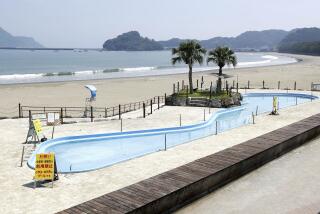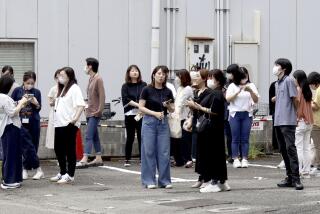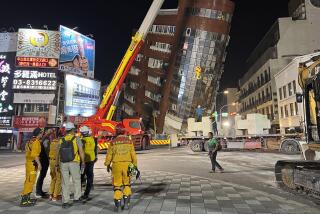Japan struggles in quakeâs aftermath
Japan struggled on Saturday to recover from its worst earthquake, which unleashed enough energy to generate a tsunami that threatened several countries along the Pacific Rim, including the United States where parts of California and the rest of the West Coast struggled to deal with rising tides.
Japan struggled on Saturday to recover from its worst earthquake, which unleashed enough energy to generate a tsunami that threatened several countries along the Pacific Rim, including the United States where parts of California and the rest of the West Coast struggled to deal with rising tides.
The death toll was expected to surpass 1,000. About 300 bodies were recovered and hundreds of other people were reported missing after the Friday quake struck about 80 miles off the coast of Sendai, a city of 1 million people north of Tokyo. The quake was measured at a magnitude of 8.9, making it the worst to hit Japan and the fifth largest in the world since 1900, according to records.
A wall of water, as high as 30 feet, pushed cars like childrenâs toys, flooding streets and vast chunks of farmland. The Sendai region was reported to be submerged, and pictures broadcast after sunrise on Saturday showed fires burning at the horizon. Aftershocks, some measured at as much as magnitude 6.0, were reported and more were expected in the next few days.
âIâm heartbroken by this tragedy,â President Obama said at a Friday afternoon news conference. âThe Japanese people are such close friends of ours. That just makes our concerns that much more acute.â
Obama said growing up in Hawaii made him more conscious of Japanâs influence and its ability to rebound from disasters.
âWhen you see whatâs happening in Japan, you are reminded that for all our differences in culture or language or religion, that ultimately humanity is one,â Obama said. The U.S. will be sending aid to the stricken areas, the president said.
The ties that bind the world were more than just a figure of speech. The earthquake sent out enough energy to make the tsunami felt across the world. The waters crashed into Hawaii with the West Coast the next target. People braced and were evacuated but the impact was milder than expected though the quake released more than 30 times the energy of the 1906 San Francisco quake.
The harbor at Crescent City in Northern California was destroyed. Four people were swept out to sea; three were injured and one was feared dead. Four people were rescued from the water in Oregon.
Precautions were taken in 20 countries along the Pacific Rim, including the Philippines, Chile and Indonesia. By Saturday, tsunami warnings had been lifted in various countries including Australia, New Zealand, Indonesia and the Philippines.
The Japan quake was the strongest since the December 2004 quake in Indonesia that left about 220,000 people dead or missing in 12 countries around the Indian Ocean.
Early estimates put the insured losses at more than $15 billion, though that figure was expected to rise. Still, the final death toll in Japan is expected to be far less than in Indonesia because of tougher building codes and better warning and evacuation systems.
One U.S. aircraft carrier is already in Japan, and a second is on its way to assist with the recovery efforts. A U.S. ship was also heading to the Marianas Islands, officials said. The Pentagon said U.S. and Japanese officials are in frequent contact about what was needed including food, water, shelter and medical supplies. The ships also have medical facilities.
The State Department said no Americans were killed or injured in Japan. Travel alerts remained in effect as most airports were closed.
An issue of special concern was the condition of a nuclear power plant in northeast Japan.
Japanâs Kyodo News Agency said that radioactive substances may have seeped from the Fukushima Daiichi reactor, about 160 miles from Tokyo. Radiation levels were reportedly eight times above normal.
Twitter.com/latimesmuskal
More to Read
Get the L.A. Times Politics newsletter
Deeply reported insights into legislation, politics and policy from Sacramento, Washington and beyond. In your inbox three times per week.
You may occasionally receive promotional content from the Los Angeles Times.











